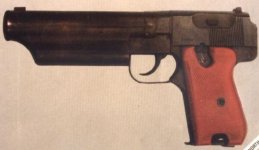Walt Sherrill
New member
44 AMP said:now here's a couple that don't move in relation to the sights..
The original discussion was about whether locking the slide could improve accuracy or had other benefits.
My point in my earlier replies wasn't to denigrate or overlook OTHER recoil systems -- your examples above are good ones. We were addressing the effect of locking the slide.
My comments were intended in support my contention that LOCKING THE SLIDE on a most semi-autos doesn't change accuracy potential -- as the things that lead to the best accuracy must be in place before the trigger is pulled -- slide movement is after the fact!
If you have to move key components to load the semi-auto, precision fit is still critical -- as the components still have to return to the same place for each shot (or in the case of the locked slide) the next shot. If barrel and sights aren't changed during the loading process or cycling, then it's a none-issue, but locking the slide also adds nothing to the accuracy equation.
Your points, above are valid -- and there are bunches of target .22s with fixed barrels and sights that are KNOWN for their accuracy. Silenced Ruger .22s were also used for assassination work in Vietnam, and pictures and stories can be found about their use on the net with just a little patience. Target .22s (and some .32s) are in a world by themselves.
My Kadet Kit, mounted on a CZ-85 Combat frame is simply outstanding. Like many .22 designs, ONLY THE BOLT moves: barrel and sights are a single assembly -- and how the .22 upper assembly fits on the frame has little effect on the gun's accuracy. I've no experience with the AMT you show (same gun from one of the Dirty Harry movies?), but it looks like a .22 on a LOT of steroids!! Some fixed barrel guns have slides which carry the sights, and the slide/sights move with each shot, so proper slide to frame fit is an issue there.
The Luger has movement between components and that can affect sight alignment -- just not a LOT. I've had a couple of Lugers and they CAN be tack-drivers. Consistent fit between the barrel which moves on the frame, the breech assembly which connects to toggle components (one of which, on some models, has the rear sight) is still important. Wear, or slop during manufacture can still affect consistent lockup. The artillery versions of the Luger have both the front and rear sights on the noticeably longer barrel; in theory, that gun could be VERY accurate./I] I've never seen one in the real world -- only photos.
Back to locking the slide: for most of the guns we've discussed, precision fit is still needed to allow components to consistently realign after each shot (or during loading) jf accuracy is to be optimal. If the gun doesn't lock everything up exactly the same before each shot, accuracy will be affected. Without that consistent lockup, locking the slide before the shot is like closing the barn door after the livestock have gotten out.
As noted in the original linked article -- locking the slide does make the weapon quieter and that was why the S&W 39 guns had that feature.
Last edited:

